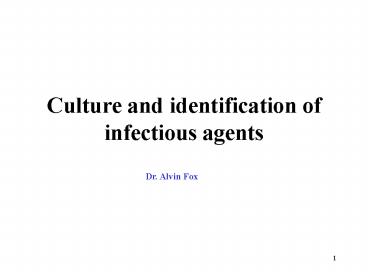Culture and identification of infectious agents PowerPoint PPT Presentation
1 / 29
Title: Culture and identification of infectious agents
1
Culture and identification of infectious agents
Dr. Alvin Fox
2
Key Terms
- After culture
- Biochemical (physiological) tests
- Genetic tests
- Sequencing,
- Polymerase chain reaction (PCR)
- DNA-DNA homology
- Restriction enzymes (digests)
- Chemical
- - fatty acid/protein profiling
- Immunological
- Direct detection (i.e. without culture)
- PCR
- Antigen detection
- Staining (e.g. Gram stain)
- Serology (antibody detection)
- Isolation (culture)
- Agar plate plate/colonies
- Liquid media
- Identification taxonomy
- Family
- Genus
- Species
- Type
- Strain
3
Taxonomy
- Defines common traits among strains for a
bacterial species - Usually genetic
- Allows development of diagnostic kits
4
Species versus strains- selecting discriminating
features
5
Classification
- Strain one single isolate or line
- Type sub-set of species
- Species related strains
- Genus related species
- Family related genera
6
Identification of infectious agents in the
diagnostic laboratory
- Aids treatment
- Helps antibiotic selection
- General hospital laboratory
- physiological tests
- Reference laboratories
- Genetic (less commonly protein) tests
7
Steps in isolation and identification
- Step 1 Streaking culture plates
- colonies on incubation (e.g 24 hr)
- size, texture, color, hemolysis
- oxygen requirement
8
Sheep blood agar plate culture
Bacillus anthracis
Bacillus cereus.
CDC/Dr. James Feeley
9
Mixed colonies
10
Isolation and identification
- Step 2 Colonies Gram stained
- cells observed microscopically
11
Gram Stain
Gram negative
Gram positive
Heat/Dry
Crystal violet stain
Iodine Fix
Alcohol de-stain
Safranin stain
12
Gram stain morphology
- Shape
- cocci (round)
- bacilli (rods)
- spiral or curved (e.g. spirochetes)
- Single or multiple cells
- clusters (e.g. staphylococci)
- chains (e.g. streptococci)
- Gram positive or negative
13
(No Transcript)
14
(No Transcript)
15
Step 3 Isolated bacteria are speciated
- Generally using physiological tests
16
Clinical Microbiology Laboratory Bench
17
Step 4 Antibiotic susceptibility testing
18
Antibiotic susceptibility testing
Susceptible
Not susceptible
Bacterial lawn
Growth
No growth
Antibiotic disk
19
Molecular differentiation
- Genomics
- Gene characterization
- Sequencing
- PCR
- Restriction digests
- Hybridization
- guanine cytosine
20
16S rRNA Sequencing
- Differentiates bacterial species
- Development of clinical tests based on sequence
(e.g. PCR)
21
Real-time PCR
ds DNA
Cycle one
Dye
Cycle two
Cycle 30
2 30
22
DNA-DNA hybridization
Strain 1
Heat
Strain 2
0 Homology
100 Homology
23
Profiles
- Long chain fatty acids
- - structural (e.g. cell membrane)
- Short chain
- - metabolic
- - volatiles
- - Fatty acids/alcohols
24
Protein profiling
- M.W. of a few characteristic proteins
- not proteomics
25
Rapid diagnosis without culture
- WHEN AND WHY?
- grow poorly
- can not be cultured
26
Streptococcal Agglutination Test
Streptococcal antigenic extract
Antibody
Latex beads
27
Bacterial DNA sequences amplified directly from
human body fluids
- Polymerase chain reaction (PCR)
- Great success in rapid diagnosis
- of tuberculosis.
28
Microscopy
- spinal fluids (meningitis)
- sputum (tuberculosis)
- sensitivity poor
29
Serologic identification
- antibody response to the infecting agent
- several weeks after an infection has occurred

